
The name "Egypt" would be derived from the name of an early king of
Egypt who was called "Aegyptus" in the Greek myths, and was descended
from Atlantean royalty. (Source: "The Atlantis Encyclopaedia" (2005), by
Frank Joseph.) The ancient Egyptians would have called their land:
"Kmt"
(pronounced as: Kemit or Kemet) which translates to "black". It is
often believed to
be referring to the fertile "black land" or the land of the black soil,
as the other part of Egypt was know as the "red land"; the barren
desert. It could also refer to the population of the
black people who would have lived here originally, as the Atlanteans -
who migrated to this place in later times - were the red people.
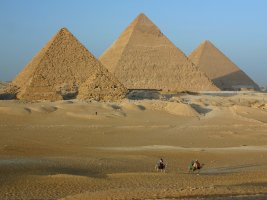 While
there are numerous pyramids
to be found in Egypt, the ones which particulary stand out in
architectural achievement are to be found at the Giza Plateau. The
ancient Egyptians called the Giza Plateau by a name which is pronounced
as: "Rostau" (Rosetau / Rosetjau).The largest one is called the "Great
Pyramid of Giza", the
only one of the "Seven Wonders of the Ancient World" which still exists
today. Its size consists of more then 6 hectares, exists of an
estimated 2.3 million blocks, and is one solid mass of stone with
corridors leading to different rooms.
While
there are numerous pyramids
to be found in Egypt, the ones which particulary stand out in
architectural achievement are to be found at the Giza Plateau. The
ancient Egyptians called the Giza Plateau by a name which is pronounced
as: "Rostau" (Rosetau / Rosetjau).The largest one is called the "Great
Pyramid of Giza", the
only one of the "Seven Wonders of the Ancient World" which still exists
today. Its size consists of more then 6 hectares, exists of an
estimated 2.3 million blocks, and is one solid mass of stone with
corridors leading to different rooms.
According to the ancient Greek historian Herodotus the Egyptians did
built this pyramid in twenty years. However, if that is true, they had
to place one block in five minutes for twenty years without any
interruptions, and installing approximately 800 tons of stone every
day. This pyramid is slightly sloped inward towards the centre of each
course, which is only really noticeable from above.
The Great Pyramid is located in the centre of the land mass of the Earth, at both longest longitude and longest latitude. It is orientated at almost exact north, south, east and west, only removed a mere three minutes from true north. Biblical archaeologist E. Raymond Capt asserts this is primary due to subsidence. (The best attempt of modern man is the Observatory in Paris, which is removed six minutes of a degree.) Many architects and engineers who studied the structure of the Great Pyramid assert that we could not duplicate the structure with our modern technology.
|
|
|
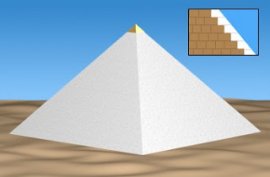 The
pyramids originally had been
fully coated with smooth casing stones of highly polished lime stone.
It is said there where originally 144,000 casing stones on the Great
Pyramid. Most of these stones where removed in later times for use in
the building of modern temples, mosques and general building
construction. We know this because a number of these casing stones are
still in place at the top of the Pyramid of Khaefre and the bottom
stone layers of the Pyramid of Menkaure. The Great Pyramid has none
left however, and besides that, it's top is missing, suggesting this
was also made of some valuable material which had been removed in the
past. (Image on the right: Representation of how the Great Pyramid
would have looked like with casing stones and a pyramidion.)
The
pyramids originally had been
fully coated with smooth casing stones of highly polished lime stone.
It is said there where originally 144,000 casing stones on the Great
Pyramid. Most of these stones where removed in later times for use in
the building of modern temples, mosques and general building
construction. We know this because a number of these casing stones are
still in place at the top of the Pyramid of Khaefre and the bottom
stone layers of the Pyramid of Menkaure. The Great Pyramid has none
left however, and besides that, it's top is missing, suggesting this
was also made of some valuable material which had been removed in the
past. (Image on the right: Representation of how the Great Pyramid
would have looked like with casing stones and a pyramidion.)
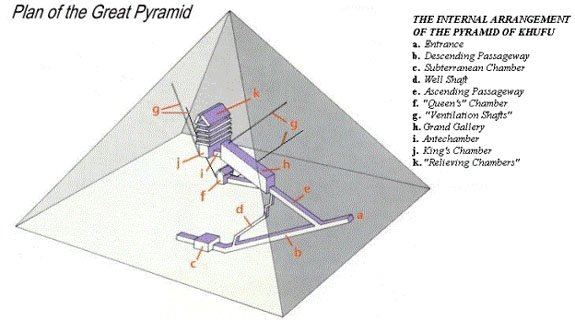
Above the roof of the so-called "King's Chamber", which is formed of nine slabs of stone weighing in total about 400 tons, are five compartments known as the "relieving chambers". In one of these chambers called: "Campbell's Chamber", there are supposed mason marks and a cartouche (seen on the image below right) on the southern roof blocks that is believed to be depicting the name of what many Egyptologists believe was the builder of the Great Pyramid, namely the pharaoh Khufu, known by the Greeks as Cheops, who would have ruled during Egypt's 4th dynasty (from 2,589 to 2,566 BC).
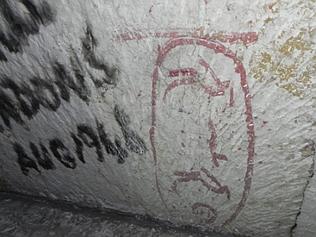 According to the ancient Arabian
legends, the Great Pyramid was build by the Biblical Saurid (also
known as Thoth/Hermes Trismegistus/Idris/Khitat) before the Great
Flood to preserve all gathered knowledge of mankind within it.
Mainstream Egyptologists however, are convinced that Khufu
would have
let build the pyramid as his own tomb; But this is questionable
however,
as there is no direct evidence for this and was not recorded in any
ancient Egyptian texts. Khufu
is sometimes regarded as a megalomaniac for the reason that he would
have built the pyramid as his tomb, but until now there had only
one image been found of this pharao which is a tiny
2 inch statue, while other rulers from other dynasties made colossal
statues
for themselves. Still, many Egyptologists see this cartouche as
undisputable proof that Khufu was the builder. It is believed that on
the cartouche is written: "the companions of Khufu"; Which
could possibly refer to the labourers who were cutting and/or
transporting the stones during the construction of the pyramid.
Khufu's sons Khafre and Menkaure would have build the other remaining
great pyramids at the Giza plateau, and another son called Djefedre
would have build another pyramid in the place Abu Rawash, whereof
today only remained its ruins.
According to the ancient Arabian
legends, the Great Pyramid was build by the Biblical Saurid (also
known as Thoth/Hermes Trismegistus/Idris/Khitat) before the Great
Flood to preserve all gathered knowledge of mankind within it.
Mainstream Egyptologists however, are convinced that Khufu
would have
let build the pyramid as his own tomb; But this is questionable
however,
as there is no direct evidence for this and was not recorded in any
ancient Egyptian texts. Khufu
is sometimes regarded as a megalomaniac for the reason that he would
have built the pyramid as his tomb, but until now there had only
one image been found of this pharao which is a tiny
2 inch statue, while other rulers from other dynasties made colossal
statues
for themselves. Still, many Egyptologists see this cartouche as
undisputable proof that Khufu was the builder. It is believed that on
the cartouche is written: "the companions of Khufu"; Which
could possibly refer to the labourers who were cutting and/or
transporting the stones during the construction of the pyramid.
Khufu's sons Khafre and Menkaure would have build the other remaining
great pyramids at the Giza plateau, and another son called Djefedre
would have build another pyramid in the place Abu Rawash, whereof
today only remained its ruins.
It is however not so obvious that the pharao Khufu was the builder of the Great Pyramid and that the pyramid served as his tomb. Although there is a large stone box in the King's Chamber that looks like a stone sarcophagus, it doesn't seem that the pharao was placed here because this chamber looks very sober and without doubt very unworthy for the great pharao. Even if all valuable artefacts had here been robbed before, in comparison to other royal graves where rich decorations and accompanying texts had been drawn on the walls, we only see empty, undecorated walls within the King's Chamber. Also, the body of Khufu had never been found.
There are theories that the body was robbed from the King's
Chamber or that there would be another secret room within the pyramid
where the mummy of the pharaoh would still be there. Certain Arabian
historians think that the presence of sea shells at the base of the
pyramid may indicate that this pyramid could have been built before a
great flood (end of the last ice age some 12,000 years ago), long
before the reign of the pharaoh Khufu. If this would be true than
Khufu and his sons only inherited and expanded the pyramid
complex.
Another cartouche on the south wall of "Lady
Arbuthnot's Chamber" had been found spelling the name:
"Khnum-Khuf", which is nowadays believed by many to be
Khufu's real name, meaning: "the god Khnum protects me." If
one finds a name in a building that wouldn't not have to mean that
this has to be the name of the one who had built it; However, these
two cartouches are still to this day regarded as the only real
"evidence" that would prove Khufu was the builder of the
Great Pyramid.
The cartouche in Champbell's Chamber had been
discovered by Howard Vyse in the year 1837. However, shortly after
the discovery people already suspected that it was Vyse himself who
painted this cartouche on this highly unusual place. One person of
his staff noticed that the paint of the cartouche was still wet. The
reason for this forgery would be that Vyse would have found nothing
of interest in the relief chambers and that he faked the cartouche in
order to extent his budget for further research that otherwise would
have been suspended; His specific task would have been to find the
evidence for what was already thought of before: that the pharaoh
Khufu would have been the builder of the Great Pyramid.
After
a thorough research in 1980, Zecharia Sitchin became convinced that
the cartouche was a forgery. (See his book: "Stairway to
Heaven".) It seems that the name of Khufu on the cartouche
initially had been spelled wrong and seemed to be corrected
afterwards. It is suspicious that this specific writing error also
occurred in the only source material about hieroglyphs that where
available to Vyse in 1837, and the kind of red ochre paint, which had
been used for the cartouche, was still in use in 1837. While there
are also unforgable quarry marks positioned behind the blocks - which
are only visible through cracks in certain stones - the cartouche
with the assumed name of Khufu however is in plain view and
could easily have been tampered with by Vyse. There can be no
conclusive evidence though whether the cartouche is real or a forgery
unless researchers date the ochre paint of these symbols, but at the
time of writing this has not ever been allowed.
(More: www.rickrichards.com,
and here: www.eridu.co.uk)
The Pyramid Shafts
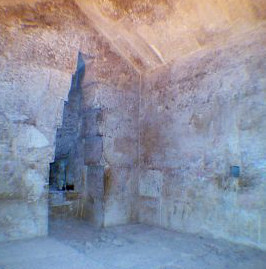 In
both the "Queen's Chamber" and
the "King's Chamber", there are two narrow shafts in the northern and
southern walls. (For the record: There
is no tradition of any queen of Egypt ever being entombed in the
pyramid of her husband.) The shafts of the Queen's chamber were
initially sealed and were discovered later by engineer John Waynman
Dixon in 1872, due to a draft that was felt in this place. Within these
shafts there also had been found a small granite ball, a piece of cedar
wood and a bronze hook, which are today called Dixon's relics. The
purpose of these objects and why these were here still remains a
mystery, although the wood fragment is considered to be part of a
measuring rod. (Image on the right: The Queen's Chamber, with the small
southern passage (shaft) shown on the right-hand side.)
In
both the "Queen's Chamber" and
the "King's Chamber", there are two narrow shafts in the northern and
southern walls. (For the record: There
is no tradition of any queen of Egypt ever being entombed in the
pyramid of her husband.) The shafts of the Queen's chamber were
initially sealed and were discovered later by engineer John Waynman
Dixon in 1872, due to a draft that was felt in this place. Within these
shafts there also had been found a small granite ball, a piece of cedar
wood and a bronze hook, which are today called Dixon's relics. The
purpose of these objects and why these were here still remains a
mystery, although the wood fragment is considered to be part of a
measuring rod. (Image on the right: The Queen's Chamber, with the small
southern passage (shaft) shown on the right-hand side.)
|
|
|
It not fully clear what the purpose of these shafts was. They appear to be aligned to stars or areas of the northern and southern skies. It was probably not meant to directly sight stars through them because the northern shaft follows a dog-leg course, unless there would ever had been placed some kind of reflecting mirrors at the bents, but such things were never found. These shafts are often explained as a doorway to the stars for the soul of the deceased pharaoh.
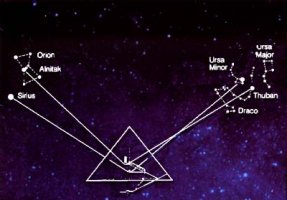
The northern shaft in the Kings Chamber is actually aligned to the North Star (a term used for the northernmost visible star.) Today this star is Polaris, appearing at the spring equinox, but in ancient Egyptian times this was the star Thuban, from the constellation of Draco. The southern shaft pointed towards the belt of Orion, which was associated with the god Osiris by the ancient Egyptians. In the Queen's chamber the northern shaft pointed towards the little dipper, while the southern shaft pointed towards the star Sirius, which was associated with the goddes Isis.
In the year 1993, German engineer Rudolf Gantenbrink did sent a small, self-made riding robot (Upuaut II) equipped with a camera, deep into the southern shaft of the Queen's Chamber. Far into the shaft he saw that it was blocked by a limestone "door" with two copper pins that looked a bit like handles, which is now being called "Gantenbrink's Door". The material and appearance of these handles is consistent with the the hook found by Waynman Dixon, as if the hook somehow could have been used to interact with the handles. The robot could not come close to the door because of jammed iron rods, assumably from earlier explorers.
|
|
|
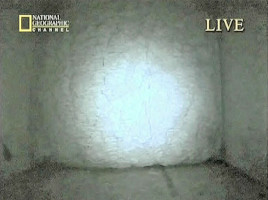 In
2002 the robot of
the National Geographic Society (Pyramid Rover) overcame these
obstacles by clamping itself to the sides of the wall by which they
could ride above the obstacles. Then it was live broadcasted on
television when they drilled a hole in this door and stuck the camera
into it to see that could be behind it. What the whole world had
witnessed next was merely an empty space with a crude wall. (See the
image right. Click here for a larger
image.) The next day they also explored the northern shaft, were sharp
turns had to be made which Gantenbrink's robot could not do. Deep into
this shaft there was also discovered a second "door" like in the
northern shaft, also with two copper pins. (Photos are copyrighted by
National Geographic Television and Film.)
In
2002 the robot of
the National Geographic Society (Pyramid Rover) overcame these
obstacles by clamping itself to the sides of the wall by which they
could ride above the obstacles. Then it was live broadcasted on
television when they drilled a hole in this door and stuck the camera
into it to see that could be behind it. What the whole world had
witnessed next was merely an empty space with a crude wall. (See the
image right. Click here for a larger
image.) The next day they also explored the northern shaft, were sharp
turns had to be made which Gantenbrink's robot could not do. Deep into
this shaft there was also discovered a second "door" like in the
northern shaft, also with two copper pins. (Photos are copyrighted by
National Geographic Television and Film.)
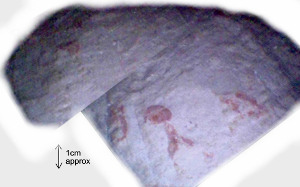 In
2011, the later
Djedi project (according to a story from the the Westcar Papyrus, Djedi
was a magician-priest who was consulted by Khufu) used a robot with a
small snake-like camera that could effortlessly pass through the hole in
the door of the southern shaft, to explore the corners of this room,
which couldn't have been done with the earlier robot. Here they
discovered red painted hieroglyphs. (Seen at the image left. Click here
for a larger image.)
In
2011, the later
Djedi project (according to a story from the the Westcar Papyrus, Djedi
was a magician-priest who was consulted by Khufu) used a robot with a
small snake-like camera that could effortlessly pass through the hole in
the door of the southern shaft, to explore the corners of this room,
which couldn't have been done with the earlier robot. Here they
discovered red painted hieroglyphs. (Seen at the image left. Click here
for a larger image.)
Luca
Maitello, an Italian researcher who specializes in ancient Egyptian
mathematics, suggested that these looked much like the hieroglyphs for
ancient Egyptian numbers; Namely the numbers 100, 20 and 1, what in
ancient Egyptian together stands for the number 121. The number 121 is
the square root of the number 11 (11x11),
and the number 11 reappears many times within the geometric
proportions of this pyramid. First, the Great Pyramid is build in the
ratio of 7 to 11. The pyramid is designed at the basis of ratio
numbers were 11 is the mayor number, and 11 is a prime number.
Possibly, this number may simply indicate where, according to the
building plan, the stone block had to be placed during the building
of the pyramid, as if one would put a number on all the pieces of a
puzzle in order to put it together effortlessly.
Illegal Samples
Further there had
been made a remarkable discovery related to the King's Chamber and
the relief chambers. Under the supervision of inspectors from the
Egyptian Ministry of Antiquities, German experimental archaeologist,
vegetation geographer, writer and teacher Dominique Görlitz (PhD)
and Stefan Erdmann took a few milligrams of ancient paint from an
inscription within Campbell's Chamber within the relief chambers (not
from the Khufu cartouche) as well some small amount of scratching of
the "black stains" from the 18 granite
beams on the ceiling
of the King's Chamber. (See the image below right.)
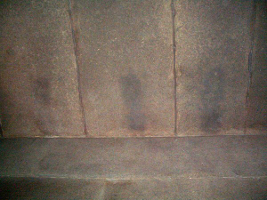 This
became known to the public because of a Youtube trailer
that had been put on the internet for a TV documentary they intended to
produce.
Documentary producer Frank Hofer however wrongly stated in the
trailer that they did take the samples from the Khufu cartouche.When
the Egyptian authorities took
note of this trailer, Görlitz and Erdmann were accused by the former
Minister of Antiquity of "stealing" or vandalizing the Khufu cartouche,
which got international news attention in December 2013. Thanks to the
help of author and investigator Robert Bauval and Professor Robert
Schoch they could prove with photographic evidence that they didn't
took samples of this specific cartouche as earlier photos clearly
showed that this cartouche was already damaged between 2004 and 2006.
Although they in fact got a private permit to investigate the Great
Pyramid, they had not asked permission to take these samples and
therefore they only got away with a minor penalty as compensation to
the Egyptian authorities.
This
became known to the public because of a Youtube trailer
that had been put on the internet for a TV documentary they intended to
produce.
Documentary producer Frank Hofer however wrongly stated in the
trailer that they did take the samples from the Khufu cartouche.When
the Egyptian authorities took
note of this trailer, Görlitz and Erdmann were accused by the former
Minister of Antiquity of "stealing" or vandalizing the Khufu cartouche,
which got international news attention in December 2013. Thanks to the
help of author and investigator Robert Bauval and Professor Robert
Schoch they could prove with photographic evidence that they didn't
took samples of this specific cartouche as earlier photos clearly
showed that this cartouche was already damaged between 2004 and 2006.
Although they in fact got a private permit to investigate the Great
Pyramid, they had not asked permission to take these samples and
therefore they only got away with a minor penalty as compensation to
the Egyptian authorities.
When the samples were scientifically tested in Germany, the scrapings from the black stains revealed that these were in fact magnetite traces, which means that here iron objects were placed against these beams as the product of corrosion shows. Possibly these iron objects were part of a tool by which these beams were brought into position, as they doesn't seem to have any obvious use on the ceiling and there are also no traces that show that they once would have been pinned into the stone. It strongly contradicts the official statements of the scholars that the builders of the Great Pyramid neither knew how to produce iron nor how to use it. This was not the first time that there had been discovered iron within the Great Pyramid, as there also had been found a metallic plate in 1883 that appeared to be iron after it had been investigated in 1989. This new discovery however is very important as it is suggestive of the usage of advanced iron equipment during the construction of the pyramid as it was previously thought they only could have used very primitive tools. (Source and image credit: atlantisforschung.de)
The Egyptian antiquities ministry placed a ban on any archaeological cooperation with Dresden University, which reportedly supported the work of the German archaeologists, as well as the scientific laboratory where the samples were analyzed. Unfortunately, the findings of both archaeologists have been rejected by the ministry, which claims that the expedition was conducted by amateurs, not expert archaeologists. (Source: Al Ahram.)
The Mysterious "Robbers' Tunnel"
According to the Greek geographer Strabo (24 BC), there originally was no visible entrance into the Great Pyramid; There would have been a (hinged) stone door which could be opened (raised) to get into the pyramid but was indistinguishable from the surrounding masonry when closed. The present day entrance, which is situated below the (supposed) original entrance, is generally believed to be forced through by the Arabs under the Calif Al-Mamun around 820 AD, and therefore called: "Al-Mamun's breach'.
However, the tunnel (now called the "Robbers' Tunnel") had been dug directly and in one go to the Ascending Passage, effectively bypassing the large granite plug blocks. (See image below.) This makes it clear that, whoever dug the tunnel, had to be very familiar with the Great Pyramids' interior. Al-Mamun's men apparently were not, because they were actually credited as the first (so far we know) to discover the interior of the Great Pyramid again after a long time. Perhaps the entrance was more or less sealed in the past and later reopened again by Al-Mamun's men, that could be the case, but it seems that the tunnel was not dug by them.
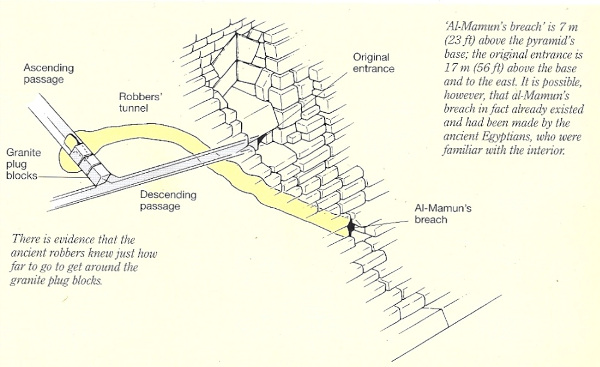
Image credit: Egyptologist Mark Lehner
Then who else could have made the tunnel to the Ascending Passage? Zecharia Sitchin's book: "The Wars of Gods and Men (1992)" could have the answer as there is the mention of the construction of artificial mounds which could refer to the pyramids (of Egypt). In chapter 10: "The Prisoner in the Pyramid", Marduk was imprisoned alive inside E.KUR (Great Pyramid), leaving him in the King's Chamber. Then the granite plugs in the Ascending Passage were placed to block the passage at the bottom, effectively trapping him inside the pyramid. Ningishzidda (Thoth), the creator of the Great Pyramid, heard of this and found a quick and efficient way to free him by digging a tunnel. From the book:
"…Still
familiar with the pyramid’s inner layout, the Anunnaki realized that
the shortest and quickest way to reach the starved Marduk was to tunnel
the connecting shaft between the existing segment "B" and "D" – a
tunnelling of a mere thirty-two feet through the relatively soft
limestone blocks; it was a task that could be achieved not in days but
in hours."
"The record of Marduk’s entombment, alive, within the Great Pyramid has been preserved on clay tablets found in the ruins of Ashur and Nineveh, the ancient Assyrian capitals. The Ashur text suggests that it had served as a script for a New Year’s mystery play in Babylon that re-enacted the god’s suffering and reprieve. But neither the Babylonian version, nor the Sumerian historical text on which the script was based, have so far been found."
Because the pyramid is heavily damaged at the location of the original entrance, it may be that there had been the attempt to force through the original entrance first, before breaking through the stone below.
Big Void Detected Within the Great
Pyramid
Starting in October 2015, the Japanse and French scientist of the
ScanPyramids team (http://www.scanpyramids.org)
began to scan the Great Pyramid with a non-invasive technique called
muography (see Wikipedia),
which makes use of the shower of high-energy particles that naturally
rain down on the Earth's surface from space. With muography density
changes can be sensed inside large rock structures and had been used
before to probe the interiors of phenomena as diverse as volcanoes and
glaciers, and had also been used to investigate the failed nuclear
reactors at Fukushima.
One year later in October 2016, they announced their discovery of
the detection of
a cavity at the north face corridor of the Great Pyramid they named:
"ScanPyramids North Face Corridor" (SP-NFC), situated above the
Descending Passage and above what would have been the original
entrance.
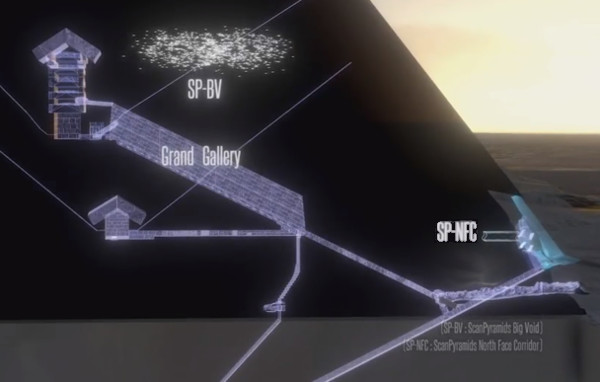
Image from the ScanPyramid presentation (Slightly edited)
Another big discovery was announced during late 2017. They had detected another anomaly which appeared to indicate a very large void above the pyramids' Grand Gallery, named: "ScanPyramids Big Void" (SP-BV, see image above). It seems to be a very large chamber or perhaps another gallery, as the void is multiple meters high, one to two meters wide, and 30 to perhaps 50 meters long. It is still unknown whether the ''chamber'' is standing horizontal as it could also have been built diagonal, like the Grand Gallery. The exact height of the location is also unknown as it could be situated much lower and closer to the Grand Gallery, compared to what is depicted in the image above. To further investigate the big void, the team is considering the concept of drilling a very small hole (3 cm) where a small flying robot could fit through, but the Egyptian authorities would have to approve it first. (Source: BBC News.)
The ScanPyramids team said that they would also have done some more
minor
discoveries within the Great Pyramid, but would announce them only when
they are almost certain about their findings. A detailled 3D
presentation
about the findings of the ScanPyramid team can be found here
on Youtube.
The
Great Sphinx
The Great Sphinx of Giza had been carved out of one single huge block of limestone, except for the paws which constists of a number of smaller stone blocks. These smaller stone blocks could be the restoration work of the Romans. The Sphinx is about 200 feet long, 70 feet high, and 38 feet wide across the shoulders. It depicts a lion with a human head. To this day no one can say with absolute certainty in whose face the Sphinx had been carved. It could be the face of a ruler or the pharaoh who ruled at that time. It is often believed that it represents the pharaoh Khahfre, but certain experts say that the facial features more closely match those of Djedefre. The head could have been recarved at one point in time - and possibly more than once - because the head is quite small in proportion to the rest of the body. In 2004, evidence was found by the French Egytplogist Vassil Dobrev, that Djedefre would have been responsible for the carving of the Sphinx at Giza in the image of his father Khufu. It has even been suggested that the head originally could have been the head of a lion. The Sphinx was painted red for much of its documented history.
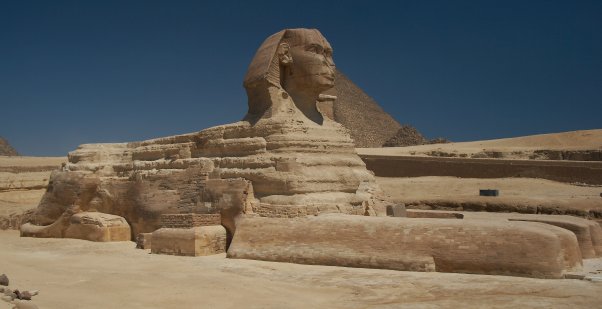
The
Great Sphinx of Giza
The Sphinx is commonly believed by Egyptologists to have been built by ancient Egyptians of the Old Kingdom in the reign of the pharaoh Khafre (ca. 2558-2532 BC). However, American Egyptologist John Anthony West found solid evidence that the Sphinx endured water erosion, which is especially visible on the walls of its enclosure. This discovery had been confirmed by geologist and writer Robert M. Schoch. According to computer models there were no long heavy rainfalls in Egypt except in the time prior to at least 7,000 BC, which means that the Sphinx is much older than considered by current mainstream Egyptologist. For mainstream Egyptologists, the patterns of erosion are merely due to the effect of wind erosion; Although this is correct for the horizontal layered erosion, wind erosion actually does not form very smooth diagonal slopes like water erosion does. Another possibility is the influence of a large flood at the end of the last ice age, around 10,000 years ago.
Psychic
Intuitives about Egypt
Trance medium Daan Akkerman asserted in
his book "Lanto 1: Atlantis" that the pyramids in Egypt
would have been built by the heirs of the civilizations of Atlantis,
when levitation, materialization and de-materialization were common
practice. The Sphinx originally had been built with the head
of a lion, but when the head did suffer from severe erosion it had
been re-carved into the head of the reigning pharaoh. This is why
the smaller head is out of proportion compared to the rest of
the body. The Sphinx was originally meant as a marker for the coming
of the age of "Leo" (some 11,000 years ago B.C.) and was
mirrored to the corresponding stars that form the constellation of
Leo. People knew in these times that the coming age of Leo would
bring huge changes for the mankind and the other creatures of the
Earth, and that the densification of matter would be so strong that
one could only work through the force of matter. All the ancient
knowledge from Atlantis and Lemuria had been stored under the Sphinx,
from where there is a doorway to a tunnel complex that leads to a
very deep and very large repository of information, which Edgar Cayce
called the "Hall of Records". (See the chapter: "The
Hall of Records".)
According to the readings of the famed American psychic Edgar
Cayce, early civilized Egypt was the result of colonization by those
who originally came from the civilization of Atlantis and her
colonies in specific parts of Europe. Possible evidence for this is
the testing of king Tutankhamon's DNA in the year 2010, which showed
that his DNA was a 99.6% match with Western European chromosomes.
(See: www.eutimes.net.)
The Sphinx and the Great Pyramid would have been built in the time
frame of 10,500 B.C. (thus before the last ice age), at the time
the high priest Ra-Ta led Egypt into a golden age of peace and
enlightenment. The face of one called Asriaio, the chief councillor
to the ruler in Egypt, was (later?) carved on the Sphinx. (See Edgar
Cayce Reading 953-24.) The building of the Great Pyramid took 100
years,
from 10,490 BC to 10,390 BC, and was directed and conceived by Ra,
where Hermes was the architect and the Isis was the advisor. (This
corresponds with the ancient Arabian legends that regarded Saurid
(Thoth/Hermes) as being the builder.) The
geometry within the structure would contain the spiritual evolution of
mankind, with periods of both progression and degression, and was
aligned with certain stars.
According to trance clairvoyant Dr. Cottrell, the shafts in the Queen's Chamber once were sighting shafts that would have been used to focus into the heavens itself. At a later time they were closed, but when they were still open they pointed to a certain alignment of astrological influences which, when this alignment would re-occur, would signify the return to that renaissance or that period of understanding, the return of the consciousness of the Law of One. This would be a return of those minds and hearts, through their experiences in Atlantis, that would come to re-open, re-experience, regenerate and rebuild the planet itself. (Source: "Rev. Douglas James Cottrell PhD: The Great Pyramid Queen's Chamber Mystery Shaft", by Rammsteinregeln.)



